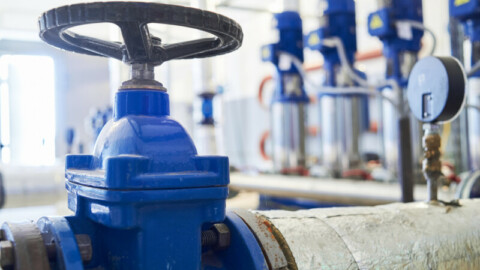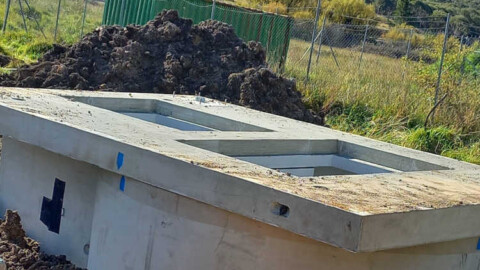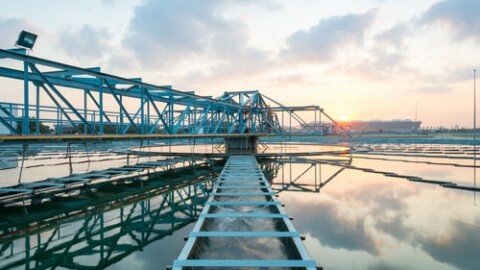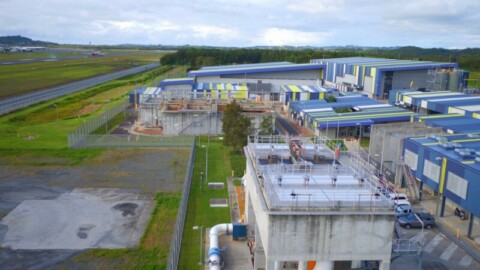
Tests of irrigation pumps across NSW commonly show that many are not performing adequately due to incorrect pump selection or wear. In the third of a series of fact sheets, the NSW Department of Primary Industries explains how you can measure the running costs and pump efficiency of diesel engine powered irrigation pumps to determine if they are performing properly.
Poor pump performance results in increased pumping costs, and can also reduce productivity as the pump is not delivering the correct amount of water to the crop. Therefore, testing your pump for water delivery and energy efficiency is essential to find out if it’s performing how it should.
Pump efficiency
Pump efficiency is a measure of how well a pump converts diesel fuel to useful work moving water. The aim of careful pump selection and regular maintenance is to have the pump performing as efficiently as possible, because this produces the lowest running costs.
Pump efficiency of 70 per cent to 85 per cent should be achievable in most circumstances. An acceptable minimum for a centrifugal irrigation pump is 65 per cent, and 75 per cent for a turbine pump.
An efficiency figure below these indicates that either the wrong pump was chosen for the job or the pump is worn and needs repair. The key to containing your pumping costs is to regularly monitor your energy usage and check on any significant change that suggests pump maintenance is needed.
Test procedure
There are two stages to testing the performance of your pump.
The first stage is to work out how much fuel is used to pump a megalitre of water. The information required is the amount of fuel used and the volume of water pumped. If you know how much you are charged for fuel, the cost of pumping can then be readily calculated.
The second stage is to work out the pump efficiency. The information required for this is the fuel consumption and the total dynamic head. The efficiency can then be roughly calculated and compared to the manufacturer’s specifications.
Both stages are explained below in a series of nine steps. When these steps are completed, you can perform quick checks from time to time to see if anything has changed, and you can estimate if the cost of repair is justified.
- What is the pumping Cost?
To work out the cost of pumping, you need to measure the fuel used and the water pumped.
The fuel in litres (L) of diesel used to pump one megalitre (ML) of water is calculated from these figures.
Step 1: Measure the fuel used
To obtain a fairly accurate idea of consumption, the fuel used for an entire irrigation should be measured. If you have fuel flow meters, you can work this out from the meter readings.
If not, it can be done by starting with a full fuel tank and measuring how much is needed to refill the tank after irrigating, or by taking dipstick readings before and after irrigating.

From this data you can calculate the fuel used per hour.

This calculation, performed regularly over a season or across seasons, will be a useful check on general fuel consumption.
If you find that, with the pumping water level the same and with the irrigation set up the same, the energy consumption is now higher, you know straightaway something has changed and you should investigate further.
When comparing figures, be sure they are from the same operating set-up, that is, pump operating at the same revs, valves or gates opened the same amount, irrigation system in the same position, with the same number of sprinklers, and so on.
Step 2: Measure the flow rate (Q)
The flow rate of your irrigation system (Q) is the volume or quantity of water pumped in a certain time – for example, litres per second (L/s), litres per hour (L/h).
Flow rate is obtained by taking readings from your water meter at the pump over, say, half an hour and dividing the volume pumped (litres (L), kilolitres (kL), or megalitres (ML)) by the time.

Flow rate = (final meter reading – start meter reading) x (60 ÷ measured time)
= (7.12685 – 6.94835) x (60 ÷ 35)
= 0.1785 x 1.7143
= 0.306 ML/h
= 306 000 L/h
Step 3: Calculate the fuel per megalitre pumped
From its fuel usage and flow rate, the litres per megalitre (L/ML) for your pump can be calculated.

Calculating this figure a couple of times over a season or between seasons allows you to check your pump’s performance. If the value changes, you should look for the reason.
Step 4: Calculate the pumping cost
To calculate the variable cost of pumping, you need to know the cost per litre of diesel. If diesel costs $1.10 per litre on-farm: Pumping cost = L/ML × cost = 88.2 × 1.10 = $97.02/ML
See Table 1 below for a list of typical pumping costs.

- How efficiently is the pump operating?
The flow rate and pressure or head that a pump is supplying is called the duty or duty point. Pump efficiency varies over the range of possible duties for any specific pump.
You can work out the approximate efficiency of your diesel-powered pump from the following information: the fuel per ML, the specific fuel consumption of the engine, and the overall pressure, or total dynamic head (H), of the system.
Note: As this method includes both pump efficiency and engine efficiency, it can only be a guide. We are assuming that the engine is in good running condition. If the results are very different from those expected, the problem may not only be with the pump: the engine may need some attention.
A fairly accurate estimate of the overall pressure or total dynamic head is the pressure at the pump discharge plus the height from the water level to the centre line of the pump (the suction lift) and suction losses plus the height from the centreline to the pressure gauge, if this distance is more than one metre (this figure is an estimate because there are many variables which are difficult to measure).
After working out your pump’s duty and efficiency, you can then find your pump’s duty point on the manufacturer’s performance curves, and read the efficiency at which the pump was designed to operate. The two efficiency figures can then be compared to see if there is room for improvement and therefore possibly a reduction in costs.
For surface irrigation systems, skip step five below. An adequate estimate of total dynamic head for surface systems is the vertical height in metres from source water level to the end of the discharge pipe, or, if the discharge is submerged, to the height of the water above the discharge, that is, water level to water level, plus suction losses due to friction.
Step 5: Determining Total Head
- Measure the discharge (or delivery) head
This is the pressure read from the gauge fitted at the pump when the system is at full operating pressure. This reading needs to be converted to equivalent metres of head.
Tip: New pumps usually have a pressure gauge installed but they often suffer physical damage quickly. A better method is to fit an access point on the delivery side of the pump where you can temporarily install a pressure gauge whenever you want to take a reading.
The gauge can be easily detached when not needed. A change in the pump operating pressure through the season or across seasons, when irrigating the same block or shift, immediately tells you something has changed.
A sudden reduction usually indicates a new leak or a blockage on the suction side; a gradual reduction usually indicates wear of the impeller or sprinkler nozzles; and an increase usually suggests a blockage somewhere in the system downstream of the pressure gauge.
Pressure can be thought of as equivalent to a pipe of water of a certain height in metres. This is referred to as ‘head’ (H). At sea level, the pressure at the bottom of a pipe of water 10 metres high is about 100 kilopascals (kPa).

If your pressure gauge reads only in psi, convert to kPa by multiplying by 6.9.

- Suction head
Suction head is the distance between the centre line of the pump and the source water level, plus losses in the suction pipe if the pump is positioned above the water level. Typical suction head figures for centrifugal pumps are three to five metres.
Most problems with pumps positioned above the water level occur in the suction line, so ensure everything is right.
Common problems include blocked inlet or foot-valve or strainer, air leaking in through joints or rust holes, pipe diameter too small, pipe damaged or crushed, suction height too great, or air trapped at the connection to the pump.
Turbine and axial flow pumps must be submerged to operate, so they usually do not have any suction head.

Another useful figure that can now be calculated is the pumping cost per ML per metre of head. This allows a meaningful comparison between pump stations.
Pumping cost per ML per metre head
= cost ($/ML) ÷ TH (m)
= $97.02 ÷ 51
= $1.90/ML/m head
Step 6: Engine derating
Specific fuel consumption is the amount of fuel used per kilowatt-hour of energy produced by the engine. It is found by dividing the fuel consumption (L/h) by the power produced by the engine (kW).
For example, if the engine in our example was producing 108 kW of power, the specific fuel consumption is 27L/h ÷ 108kW = 0.25L/kWh.
Specific fuel consumption is about 0.25L/kWh at sea level at 25°C for most large diesel engines (over 70kW).
For smaller engines it is about 0.3L/kWh. A more accurate figure may be obtained from the engine manufacturer’s performance sheets.
Specific fuel consumption varies depending on altitude, temperature, general condition of the engine (especially the air filter), auxiliary fittings, and so on.
So measuring the energy used by the motor that drives the pump includes inefficiencies in the motor itself and the drivetrain as well as the pump.
In order to calculate pump efficiency correctly, energy losses due to the motor, transmission, climatic conditions etc. are accounted for through a process called derating.
- Altitude derating (Dr)
If the altitude is significantly above sea level, the power produced by diesel engines is less. If the diesel engine is, for example, 200m above sea level, it will produce 99 per cent of the power at sea level. For our calculations, this is expressed as a decimal, 0.99.

- Temperature derating (Dt)
Higher air temperatures reduce the efficiency of internal combustion engines.
The tables below show derating factors for a range of temperatures for both naturally aspirated and turbocharged engines.
 For example, at 30ºC a naturally aspirated engine will have a power loss of 3.6 per cent. That is, it produces only 96.4 per cent of the power compared when the air temperature is 20ºC. This means the temperature derating factor (Dt) is 0.964.
For example, at 30ºC a naturally aspirated engine will have a power loss of 3.6 per cent. That is, it produces only 96.4 per cent of the power compared when the air temperature is 20ºC. This means the temperature derating factor (Dt) is 0.964.
Turbo-charged engines are usually more efficient than naturally aspirated, so although the percentage loss due to increased air temperature is greater, the engine efficiency may still be higher.
Step 7: Determine transmission losses (Df)
If the engine is not directly coupled to the pump, there is a loss of energy through the transmission. This loss is taken into account by what is termed the drive factor (Df).

Step 8: Calculate pump efficiency
Pump efficiency (Pe) using a diesel engine can be derived from the following calculation:
Pe = (272 × TH × SFC) ÷ (L/ML × Dr × Df × Dt)
Where:
272 = a conversion factor
TH = Total Head (m)
SFC = Specific fuel consumption (L/kWh)
L/ML = Fuel use per ML of water pumped
Dr, Df, Dt = De-rating factors
This example includes the data from the previous steps we have discussed. The drive from the motor to the pump is a gear drive in this case.
Pe = (272 × TH × SFC) ÷ (L/ML × Dr × Df × Dt)
= (272 × 51 × 0.25) ÷ (88.2 × 0.99 × 0.964 × 0.95)
= 3468 ÷ 79.97
= 43 per cent
Because this efficiency figure is approximate, use it as a guide only. If it is much worse than the value the manufacturer’s performance sheets indicate, repair is probably needed.
Step 9: Calculating potential savings
Most centrifugal pumps are designed to operate at about 75 per cent efficiency, and most turbine pumps are designed to operate at about 85 per cent efficiency.
The pump in our example is only about 43 per cent efficient so how much would be saved by improving the efficiency from 43 per cent to 75 per cent?
Our pumping cost is $97.02 per ML. The improvement is calculated as follows:
Cost saving =97.02 – (97.02 x 43) 75
= 97.02 – 55.62
= $41.40 per ML
If 900ML are pumped during a season, the total cost saving is $41.40 × 900 = $37,260.00.
If impeller wear is the problem and the cost of replacement is $10,000.00, it would be paid for in about a third of a season, and after that the savings are increased profit.
Notice that a reduction in the pump efficiency figure of 32 per cent (75 per cent to 43 per cent) causes an increase in pumping cost of 74 per cent ($55.62/ML to $97.02/ML).
Other factors that affect cost and pump efficiency
Pump speed
The manufacturer’s pump performance charts are usually produced for specific pump speeds and impeller sizes.
The pump speed must be known in order to interpret the manufacturer’s pump performance charts. Because diesel engines can be set to run at any rpm within their range, it is essential to know the rpm. If a rev counter is not fitted, obtain a portable unit.
If the engine is not directly coupled to the pump, the speed is altered by the gearing ratio of the transmission. Gear drives normally have the ratio stamped on the identification plate.
The ratio for a V-belt and pulley drive can be calculated from the diameter of the pulleys on the motor and the pump (see diagram below).
Caution: Ensure the motor is off and not moving before attempting to take measurements.

Impeller size
The manufacturers may offer impellers of different diameters for the same pump casing to give a different range of duties. The impeller sizes available are shown on the performance charts.
You need to know the diameter of the impeller fitted to your pump to work out which performance curve applies to your pump.
Sometimes an impeller is deliberately reduced in diameter to a non-standard size to adjust the pump’s performance and obtain a specific duty, particularly in direct coupled units.
Sometimes the impeller size is stamped on the pump’s ID plate. If not, you need to find out the size by dismantling the pump and measuring it, or asking the person who made the change.
Impeller wear has the same effect as a reduction in size, that is, it reduces the pump flow rate and efficiency.
Overall, keeping track of your pump’s performance and costs is not difficult. It may save you a lot of money and keep your irrigation system performing properly.
Acknowledgements
Agfact E5.12, August 2004, Peter Smith, Irrigation Officer, Tamworth
The NSW Department of Primary Industries publishes fact sheets on pumps and irrigation systems. To view other fact sheets in this series or for more information visit http://www.dpi.nsw.gov.au/content/agriculture/resources/water/irrigation/systems.
View the first NSW Department of Primary Industries fact sheet article here and the second here.


















